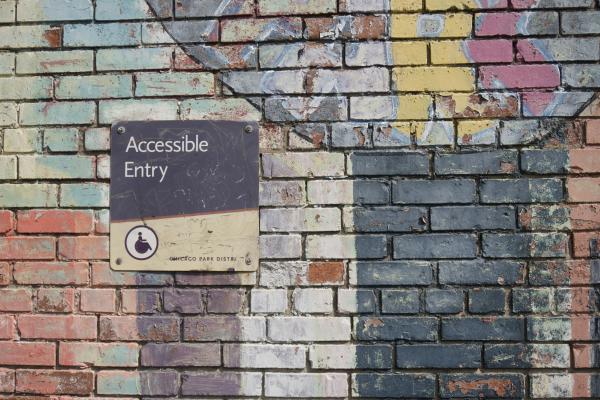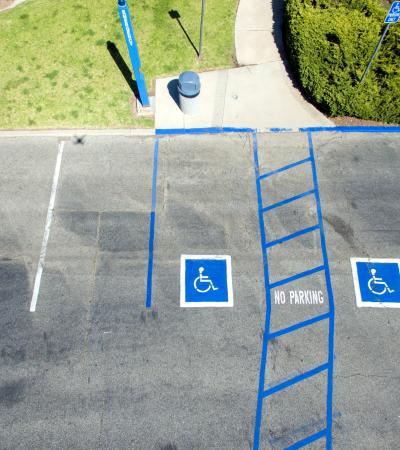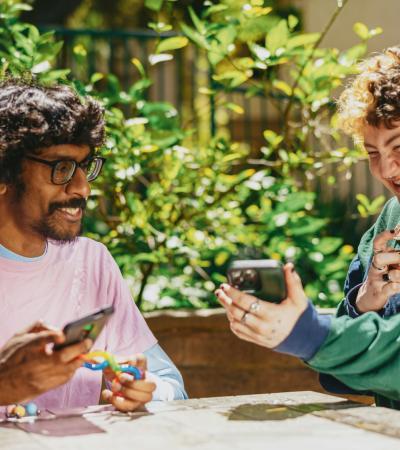In 2022, the American Library Association (ALA) launched a grant opportunity through its Libraries Transforming Communities (LTC) initiative to fund hundreds of small and rural libraries looking to better serve the needs of patrons with disabilities. To help them learn more about these needs, grant recipients were asked to host at least one community conversation with patrons with disabilities. Grantees were provided with an accessible conversations facilitation guide that laid out some strategies for making community conversations accessible for people with disabilities.

In this post, we share some of the ways that LTC libraries put the facilitation guide into practice in order to engage populations with disabilities. In each section, we also offer additional insights that libraries can use to build accessibility into their own community conversations. Our findings are based on an analysis of interim reports provided by 213 LTC libraries.
For many LTC libraries, ensuring the accessibility of their community conversations was a process consisting of several different steps. These took place before, during, and after the event itself.
Before the conversations
Before hosting their conversations, LTC libraries had to figure out the best methods to get in contact with people living with disabilities, including those who were not library patrons or who were not reachable through traditional communication channels.
To get in touch with these individuals, LTC libraries often disseminated information about their upcoming conversations in places they were likely to frequent. For example, several libraries who are focusing their projects on children with disabilities decided to publicize their conversations at school events. Parkston Public Library in Parkston, SD, reached its target audience of older adults with mobility disabilities by posting flyers around town and held its conversation at a pick-up point where meals are distributed to this group. Other libraries made similar efforts to reach community members with disabilities by placing publicity materials in strategic locations. The places they posted the information varied widely, from grocery stores and gas stations to local businesses and even on the screen at a movie theater!
Some libraries also invited people with disabilities (or other kinds of disability experts) to do a walk-through of their buildings before hosting the event. Boylston Public Library in Boylston, MA invited a disability activist and published author of books about autism to conduct an accessibility audit of its space and point out what changes would need to be implemented to increase accessibility for neurodivergent children. Similarly, Louisburg College’s library in Louisburg, NC, received accessibility advice from a person with low vision who walked through the space before the community conversation. They provided library staff with a list of potential updates that would make the space friendlier for people with vision and mobility disabilities.
Tips:
For effective outreach, meet community members where they are.
Research and get to know your target audience.
Place promotional flyers and publicity materials strategically around town.
Ask an expert to do a walkthrough of the library space.
During the conversations
Libraries took a variety of steps to ensure that their community conversations were accessible to people with disabilities. Belen Public Library in Belen, NM was one of several libraries to bring ASL interpreters to their community conversations, both to sign for people who were deaf or hard of hearing and to share their own perspectives on accessibility. To make its community conversation accessible and welcoming to neurodivergent patrons, Cutler Memorial Library in Plainfield, VT avoided hosting the event in its indoor space(which could pose problems for individuals with sensory processing issues) and instead hosted this outdoors under a tent.
To encourage participation from groups with different kinds of disabilities, other libraries held their conversations in multiple formats. Many opted for a hybrid approach to the events, hosting them both in-person and online. Others offered interactive, hands-on methods for providing feedback. For example, the library at Saint Marys Area Middle School in St. Marys, PA, built a “graffiti wall” where conversation participants could draw or write their suggestions for enhancing library accessibility.
Libraries also worked to decenter the library itself as the space where community conversations take place. Instead of hosting events in their own buildings, various libraries implemented feedback processes outside the library walls, through surveys and phone calls. Cherokee Public Library in Cherokee, IA hosted its conversations in assisted living facilities but recognized that doing this would not allow the library to reach individuals who required services at home. To include this group in the planning process, the library sent out questionnaires through a home meal delivery program. Mooers Free Library in Mooers, NY also moved outside the library to collect feedback from its target audience: older adults with mobility disabilities. To reach individuals who would not be able to attend an in-person conversation, they collected input through phone calls.
For many libraries, the decision to offer multiple options for the time, place, and format of their community conversations led to high levels of attendance and participation. By hosting events at locations that were more accessible than their own building, staff at the Joeten-Kiyu Public Library in Susupe, MP were able to gather input from 120 people. Similarly, by hosting conversations on site and at a community center and an assisted living facility, Conrad Public Library in Conrad, IA gathered feedback from 57 people.
Tips:
Make a list of possible accessibility needs.
Remember, not all disabilities are visible – don’t forget about non-apparent disabilities!
Mix up your conversation formats.
Offer virtual and hybrid attendance options.
Ask yourself: How can I make my event more family-friendly?
Think about hosting the event outside the library.
After the conversations
Some libraries continued collecting input from their communities after their events had already ended and, in doing so, ensured that a broader range of individuals would be included in the community conversation process. Hinsdale Public Library in Hinsdale, MA made its planning process more inclusive by creating a suggestion box to collect input from patrons who were unable to attend the community conversation. Other libraries took similar steps and created ongoing displays inside and outside of the library to gather recommendations from a broader swath of the community. At the Marcellus Township Wood Memorial Library in Marcellus, MI, library workers created a bulletin board display that provided details about the LTC grant and provided space for patrons to make additional suggestions anonymously. They also added a list of the accessibility needs and recommended changes that resulted from their community conversations and encouraged patrons to place stars next to the changes they would like to see implemented.
Other libraries opened additional channels for community members to get involved in the planning process after the conversations. Some recorded their conversations and distributed them broadly within their communities. Others provided the library’s address, email, and phone number to individuals who attended the conversations, and encouraged them to share this information with friends and family members with disabilities who may not have been able to attend the in-person conversation. Finally, feedback processes that were implemented in multiple languages increased accessibility for many patrons, who would not be able to provide their feedback in English alone.
Tips:
Remember that input gathering doesn’t have to end once your event does.
Ask yourself: What other feedback channels exist that I can make use of?
Record your event and share it widely.
Collect additional input through long-lasting displays or suggestion boxes.
Offer your audience ways to share their opinions in their own language or format.
Conclusion
LTC libraries pursued a number of creative strategies to make their community conversations as accessible and inclusive as possible. The steps many took to gather the perspectives from people with different disabilities began before the conversations took place and continued after they ended. As LTC libraries continue to develop their accessibility projects, using what they learned from their community conversions, we are eager to hear more about their key takeaways as well as the challenges they are overcoming and the different routes they are taking toward becoming more inclusive spaces.
About this Article
This article is part of a series of blog posts exploring how libraries that received funds through ALA’s LTC: Accessible Small & Rural Communities are working to better meet the needs of patrons with disabilities. In other posts in this series, we look at attempts to put the disability rights movement’s ethic of “Nothing About Us Without Us” into practice and consider efforts focused on neurodivergent patrons and older adults. For more on how libraries can become more accessible to patrons with disabilities, see the collection of resources we assembled. And for more information about LTC, see our historical overview of this initiative.
Knology is a nonprofit research organization that produces practical social science for a better world. The organization pursues this goal to help professionals in a variety of sectors build inclusive, informed, and cooperative societies that can thrive together with the natural systems on which we all depend. As a transdisciplinary collective of over 30 social scientists, writers and educators, the organization's work process is built on equity, transparency and deliberation.



